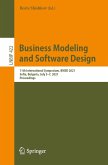This textbook shows how to develop the functional requirements of (information) systems. It emphasizes the importance to consider the complete development path of a functional requirement, i.e. not only the individual development steps but also their proper combination and their alignment.
The book consists of two parts: Part I presents the underlying theory while Part II contains various illustrative case studies. Part I starts with an introduction to the topic (Chapter 1). Then it explains how to develop functional requirements that represent the conceptual dynamics of an information system (Chapters 2 and 3). Chapters 4 and 5 explain how to model the conceptual statics of an information system. Chapter 6 gives some directions for implementation. Finally, Chapter 7 explains how a 'technical manager' can organize and manage the development process.
As an illustration of the theory, Part II contains three substantial case studies. The first one (Chapter 8) presents a stepwise development starting from an informal situation sketch via a simple domain model towards a precisely specified, full-fledged conceptual data model, which finally is translated to an SQL database. In the second case study (Chapter 9) the author converts the well-known non-trivial use case Process Sale from Larman into a textual System Sequence Description (SSD). For validation purposes, that textual SSD is subsequently translated into natural language and into a graphical SSD. The third case study (Chapter 10) shows the applicability of the author's approach to a control system and also illustrates the typical situation that the requirements are constantly changing during development.
This book is written for (under)graduate students in software engineering or information systems who want to learn how to carry out adequate problem analysis, to make good system specifications, and/or to understand how to organize and manage anIS-development process. It also targets practitioners who want to improve their problem analysis abilities and/or their ability to make good system specifications. To this end, it includes more than 150 explanatory figures and is accompanied by a Web site which provides additional course material such as slides, additional exercises, solutions to exercises, and the code for the figures used in the book.
The book consists of two parts: Part I presents the underlying theory while Part II contains various illustrative case studies. Part I starts with an introduction to the topic (Chapter 1). Then it explains how to develop functional requirements that represent the conceptual dynamics of an information system (Chapters 2 and 3). Chapters 4 and 5 explain how to model the conceptual statics of an information system. Chapter 6 gives some directions for implementation. Finally, Chapter 7 explains how a 'technical manager' can organize and manage the development process.
As an illustration of the theory, Part II contains three substantial case studies. The first one (Chapter 8) presents a stepwise development starting from an informal situation sketch via a simple domain model towards a precisely specified, full-fledged conceptual data model, which finally is translated to an SQL database. In the second case study (Chapter 9) the author converts the well-known non-trivial use case Process Sale from Larman into a textual System Sequence Description (SSD). For validation purposes, that textual SSD is subsequently translated into natural language and into a graphical SSD. The third case study (Chapter 10) shows the applicability of the author's approach to a control system and also illustrates the typical situation that the requirements are constantly changing during development.
This book is written for (under)graduate students in software engineering or information systems who want to learn how to carry out adequate problem analysis, to make good system specifications, and/or to understand how to organize and manage anIS-development process. It also targets practitioners who want to improve their problem analysis abilities and/or their ability to make good system specifications. To this end, it includes more than 150 explanatory figures and is accompanied by a Web site which provides additional course material such as slides, additional exercises, solutions to exercises, and the code for the figures used in the book.
Dieser Download kann aus rechtlichen Gründen nur mit Rechnungsadresse in A, B, BG, CY, CZ, D, DK, EW, E, FIN, F, GR, HR, H, IRL, I, LT, L, LR, M, NL, PL, P, R, S, SLO, SK ausgeliefert werden.









